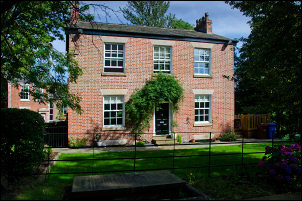|
Sat 8 Sept 2012
Historical tour of Chorley Unitarian Chapel by Doreen Jolly |
|
Chorley
Unitarian Chapel
Every year over a weekend in September, Heritage Open Days
celebrate England’s fantastic architecture and culture.
Buildings of every age, style and function open their doors to
the public and many have free conducted tours.
As part of Chorley’s celebrations Chorley Unitarian Chapel, Park
Street, was open on Saturday 8th September with a display of
documents and photographs that illustrated its history. After an
introductory talk by Doreen Jolly about the formation of the
church and it’s very important place in Chorley’s history Doreen
gave an enlightening tour of the grounds and gravestones. |

Chorley Unitarian Chapel |
|
Her story began
in 1662 with the ‘Act of Uniformity’, which made it law that the
Book of Common Prayer had to be used. The following years saw
protestant dissenters persecuted for non-conforming.
In 1662 the Rev Henry Welch was ejected from Chorley Parish
Church of St Laurence on his refusal to conform to the Act. He
and his followers became the first non-conformists. In 1724
Abraham Crompton of Chorley Hall bequeathed land and money for a
Chapel and so the existing Church was built in 1725, making it
the second oldest in Chorley. The first recorded Minister was
Samuel Bourn who was Minister from 1728 to 1732.
During the Jacobite rising of 1745 Bonnie Prince Charlie
(Charles Edward Stuart) marched from Scotland heading towards
London. He only got as far as Derby before retreating back to
Scotland and his subsequent defeat at Culloden in 1746. On his
journey south he stayed at Chorley Hall and some of his
followers stayed at the Chapel’s Manse and reputedly consumed
the entire store of cheese! The whereabouts of this Manse isn’t
known as the current Manse only dates from 1823. |
 |
|
Probably the
most famous Minister was Reverend William Tate, minister from
1799-1836, and father of Sir Henry Tate (born 1819), founder of
Tate & Lyle plc and donor of the Tate Gallery in London.
The Manse was the childhood home of Sir Henry Tate. This is
commemorated on a plaque erected by Chorley Civic Society. Sir
Henry was educated there at a school run by his father which
helped supplement the Minister's small stipend. |

Doreen by the Crompton grave |
|
Sir Henry was a
generous benefactor to Chorley, providing money to buy books in
the new Free Library in Avondale Road. The organ and central
choir seats in the chancel were donated by Sir William Tate -
Grandson of the Reverend William Tate - in 1902.
In the churchyard is the tomb of the Reverend William Tate and
members of his family. |
|
A survey of the
Church was carried out in the early 1960s and certainly pulled
no punches. Some extracts from the report are as follows:
“Outside the Church Walls looked like Dartmoor Prison on a damp
Friday; the stout stone or granite walls will sooner or later
lose their battle with the heavy shrubbery and young trees that
seem to be springing out of their very foundation.”
“The Pews need stripping down to their virgin pitch-pine and
never again, ever, should they be varnished; but properly
wax-polished.”
|

Unitarian Chapel in the 1800s |
|
The chapel was
completely restored and refurbished by Leonard M Fairclough in
1963 in memory of his father, Leonard Fairclough, who was born
in 1849 and died in 1927.
The history presentation and tour of the graveyard was attended
by 32 visitors. |

The Manse |
|